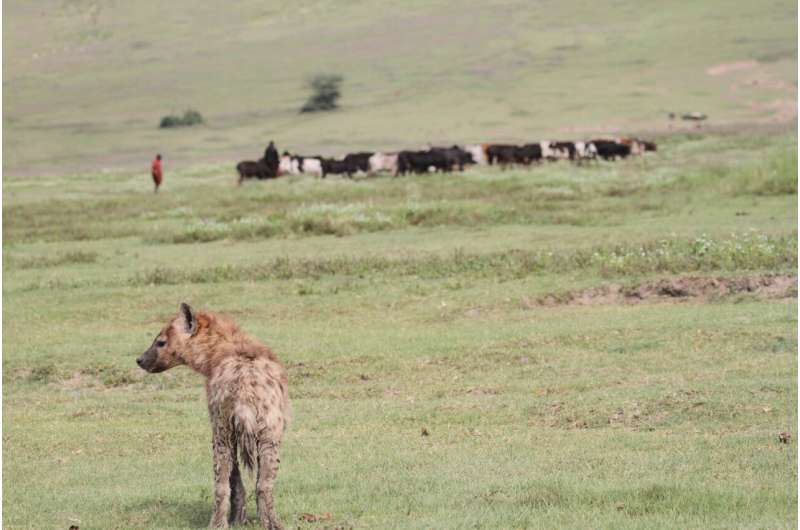Daytime pastoralist activities do not negatively affect spotted hyenas in Tanzania

Pastoralists herding their livestock through the territories of spotted hyena clans along dedicated paths during daytime do not reduce the reproductive performance of hyena clans, nor elevate the physiological "stress" of spotted hyenas. This is the result of a new study led by scientists from the Leibniz Institute for Zoo and Wildlife Research (Leibniz-IZW) and the Ngorongoro Conservation Area Authority (NCAA).
The scientists analyzed 24 years of demographic and physiological data from eight spotted hyena clans—two of which were exposed to activities by pastoralists. The activities of pastoralists were predictable, diurnal and did not disrupt important behaviors in the mostly nocturnal hyenas. This may have allowed the population to perform well, the scientists suggest. The open access paper is published in the Journal of Animal Ecology.
Human activities can strongly affect wildlife but the effects can vary greatly, depending on the type of activity and the characteristics of the wildlife species involved. To promote human-wildlife coexistence, it is therefore important to assess which activities are sustainable for a given species.
Most past research has documented major changes in the behavioral response of such species to human activities, but did not examine whether such changes are indicative of the Darwinian fitness of wildlife (in terms of its survival and reproductive success) or physiological effects such as "stress" or allostatic load, which are much more relevant to conservation.
"Acquiring the long-term data for such research—especially on large, group-living carnivores, which may be particularly conflict-prone—is not easy because of the enormous financial and temporal demands involved. We assessed for the first time the Darwinian fitness and the physiological effects of a common human activity—livestock herding—in light of the biology and social system of our wildlife species," explains first author Arjun Dheer, doctoral student at the Leibniz-IZW.
The investigation was conducted on eight clans of spotted hyenas (Crocuta crocuta) living in the Ngorongoro Crater, a UNESCO World Heritage Site in northern Tanzania. "Livestock grazing and using mineral licks occurred predictably on a near-daily basis within the territories of two of our eight study clans between 1996 and 2016," adds Dheer.
This created a natural experiment of exposed and unexposed clans which the scientists exploited. "We tested whether the hyenas of the exposed clans had fewer surviving offspring than the unexposed hyenas and whether the herding activities increased the physiological 'stress' of the hyenas," explains Dr. Oliver Höner (Leibniz-IZW), head of the Ngorongoro Hyena Project and senior author of the paper.
To assess the fitness effects, the scientists used 24 years of detailed demographic data from the eight clans and to estimate physiological stress, they measured the concentration of glucocorticoid metabolites (fGMC) in 975 feces from 475 hyenas. The team also accounted for the effects of additional ecological parameters such as disease outbreaks and the abundance of African lions (Panthera leo), the hyenas' main competitor, and prey.
The main result was that hyena clans exposed to Maasai pastoralists moving through their territory with their livestock had similar juvenile recruitment and fGMC levels as unexposed clans. "Our results suggest that the hyenas in the Ngorongoro Crater coped well with daytime pastoralism," explains Dheer. A likely explanation for the lack of detectable effect on hyenas is that the activity was predictable and minimally disruptive because it occurred during daytime.
"Hyenas are mostly nocturnal when it comes to critical behaviors such as hunting," explains Höner. Even if pastoralist activities forced other critical hyena behaviors such as the nursing of young cubs into nighttime, it might not have been too much of an adjustment for them to make. "Spotted hyenas are behaviourally flexible. In other areas, they were observed to move their cubs to dens further away from the paths that pastoralists used, or to nurse more at night," Höner says.
The authors caution that such results should not be extrapolated in uncritical fashion. "In areas where pastoralism is more intense and environmental conditions such as the abundance of wild prey are less favorable than in the Ngorongoro Crater, pastoralist activities may well have a significant detrimental effect even on a behaviorally highly flexible species such as the spotted hyena," explains Höner.
"Our investigation highlights the need to develop evidence-based coexistence strategies within a local context to benefit both stakeholders and wildlife. It also underscores the importance of interpreting the effects of human activity in light of the socio-ecology of the species of conservation interest," concludes Victoria Shayo (Head, Department of Wildlife and Rangeland Management, Ngorongoro Conservation Area Authority). Additional scientific analyses that cover a variety of anthropogenic activities and species—and that measure effects on fitness and physiology—will be conducive to promoting human-wildlife coexistence.Emotions and culture are most important for acceptance of carnivore management strategies
No comments:
Post a Comment